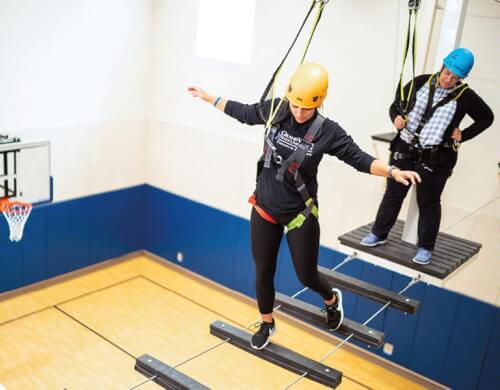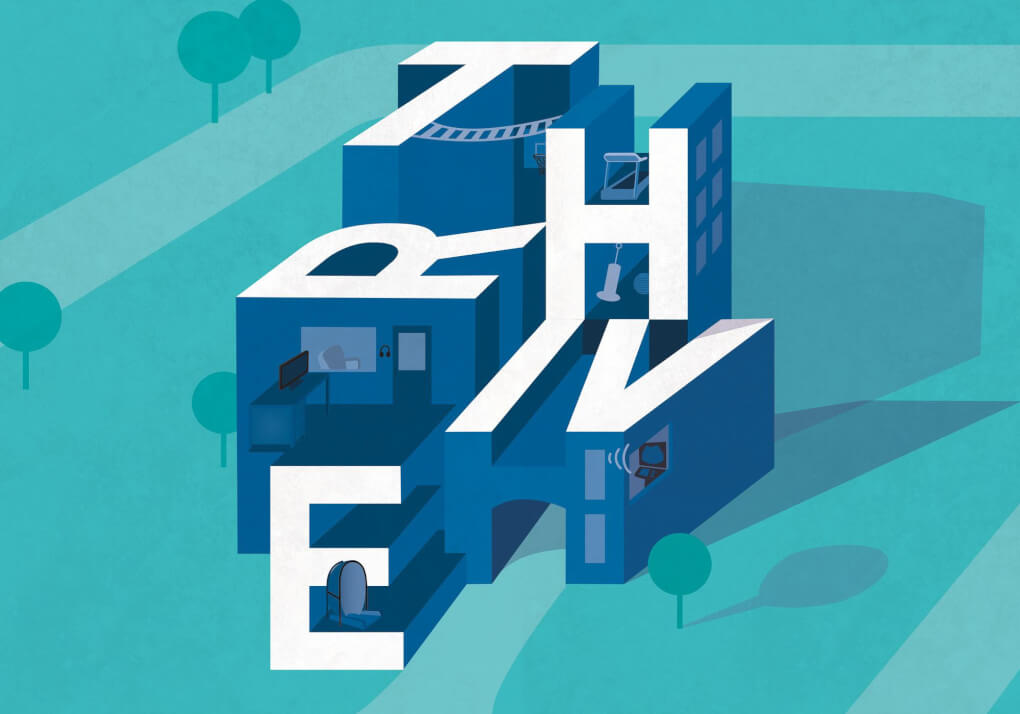Elena Brownell was shaking a bit as she carefully walked along the suspended ropes course high above the floor of the two-story therapeutic recreation lab in Raleigh J. Finkelstein Hall. The senior, majoring in therapeutic recreation, was learning what it is like to rely on others to safely get to the other side.
“This exercise is used in the area of behavioral health, like for those battling substance abuse,” Brownell explained. “It builds trust and team skills, and demonstrates how to overcome challenges.”
Brownell said conquering the ropes course will help her better relate to future clients. “I can meet them where they are; I know that heart-pounding adrenaline rush they are feeling. I will know how to help them in a scary situation,” she said.
The ropes course is just one of the unique pieces of equipment inside Finkelstein Hall, which opened for classes in May. Health students are learning on instrumentation that isn’t found anywhere else in the state.

ENHANCED LABS, INTERACTIVE LEARNING
The five-story, 84,000-square-foot health building is located one block north of Grand Valley’s Cook-DeVos Center for Health Sciences (CHS) on the Medical Mile in Grand Rapids.
In response to a growing number of health-related programs and students, Finkelstein Hall expanded Grand Valley’s Health Campus, providing 16 teaching labs for occupational therapy, therapeutic recreation, speech-language pathology, sonography, public health, and allied health programs — all programs that require intensive, interactive learning spaces.
The communication sciences and disorders program, which includes speech-language pathology and audiology, has experienced tremendous growth.
Classes for the program occupy the entire third floor of Finkelstein Hall with several labs, including a child lab suite, a vestibular lab (for inner ear and balance), a listening lab, an adult lab and a sound suite, to name a few.
Students are learning on a new neuroscan system, a 64-channel recording system for brain mapping and scanning brain activity of patients listening to human speech rather than beeps or tone bursts.
“This is used for estimating hearing sensitivity,” said Dan Halling, chair of the department. “Very few places in the country have started to use complex stimuli like actual speech. Different areas of the brain light up to speech, and that’s what we are interested in, how people process speech.”

The program also features a virtual computerized dynamic posturography system used for patients suffering from dizziness or balance issues — it is the only system of its kind available in Michigan.
“We actually surround patients with a virtual image and then we can manipulate that image in response to their movement,” Halling explained. “We can control the visual environment as well as the platform they stand on. This allows us to tease out the possible issue, whether it’s vision, muscle feedback, inner ear, etc.”
Finkelstein Hall is providing expanded space for students studying diagnostic medical sonography (DMS) or cardiovascular sonography, with the newest ultrasound machines from multiple vendors.
“We have equipment from all the major vendors across the world, so we are able to mirror a clinical environment for students while also exposing them to a variety of machines, making them more marketable and adaptable,” said Jennifer VanderPoel, program director for vascular sonography.
VanderPoel said there are also high-definition monitors on each side of the lab for collaborative learning. “Instead of huddling around a small screen of the ultrasound, it’s projected on the monitors so students being scanned and others in the lab can see what’s happening,” she explained. “Instructors can quickly assess student progress.”
Dr. Tatyana Beaves, MD and DMS program director, said students are also able to learn on a self-guided simulated system to practice more invasive ultrasound procedures. “This system mirrors resistance of human tissue and provides students with feedback while they are scanning,” said Beaves. “It also includes a library of cases from around the world so students can evaluate normal and abnormal pathologies.”

GROWING PROGRAMS, MEETING DEMAND
Grand Valley offers the most comprehensive array of health sciences programs in Michigan with 20+ programs in nursing and health professions. More than 5,000 students are currently enrolled in health-related courses.
Roy Olsson, dean of the College of Health Professions, said the new space for each program inside Finkelstein Hall is substantially larger, allowing faculty members to teach their students differently.

“Faculty members can have more students in the lab at one time and teach more efficiently,” said Olsson. “The teaching labs can be used as both a traditional classroom and an interactive space for hands-on practice.”
For example, in the therapeutic modalities lab, occupational therapy students can receive instruction at one end of the lab and walk to the other end to work with standardized patients (people trained to portray patients with various conditions). The lab features various equipment, including suspended swings used in pediatric practice settings.
“The standardized patients teach us a great deal,” said Ella Savalox, a senior majoring in occupational therapy. “They are great at imitating situations we may encounter. Field work educators say Grand Valley occupational therapy students have good critical thinking skills because of all the hands-on work we get.”
Olsson said Finkelstein Hall was designed with growth in mind. “We calculated the space needed for programs that will be expanding in the future and we have the equipment for those programs. So, when we’re ready to open them in the next two-to-three years, we’ll be able to do that,” he said.


HEALTH CAMPUS ANCHORS EAST END OF MEDICAL MILE
Grand Valley celebrated the continued expansion of its Health Campus October 23 with a groundbreaking ceremony for a third health building — the Daniel and Pamella DeVos Center for Interprofessional Health.
The five-story building is under construction right next to Grand Valley’s Cook-DeVos Center for Health Sciences on the Medical Mile in downtown Grand Rapids.
When completed in May 2021, it will include 15 classrooms and 14 interactive laboratories designed for collaborative work and equipped with state-of-the-industry simulation and technology.
Provost Maria Cimitile said the new health building will be the flagship of the Health Campus, allowing for interaction between students from all nursing and health professions programs.
“The DeVos Center for Interprofessional Health will change the essence of the Health Campus,” said Cimitile. “There will not be another university teaching health sciences that will have the space and programs to offer true interprofessional education. Students will want to come here to access all that we have.”


GVSU, GRAND RAPIDS COLLABORATE ON AFFORDABLE HOUSING PROJECT
A project to bring new affordable housing to a Grand Rapids neighborhood is one step closer to reality.
At a Board of Trustees meeting in July, trustees authorized the university to lease property on its Health Campus in Grand Rapids to a developer who intends to build affordable housing compatible with the Belknap Lookout neighborhood.
Patricia Waring, director of Community Relations at Grand Valley, and others from the university worked with representatives from the City of Grand Rapids and from the Neighbors of Belknap Lookout (NOBL) to create a Memorandum of Understanding after the university purchased land to expand its Health Campus north of Michigan Street. The MOU required the committee to prepare a request for proposal and choose a developer.
The board’s action authorizes Grand Valley to lease .85 acres to Three CPK, which is a joint venture of Third Coast Development and PK Housing, for development of the affordable housing project, which is a provision of the MOU. Housing will be built on the south side of Trowbridge, between Lafayette and Prospect, in the Belknap area of the city of Grand Rapids.
The project will have a housing mix of 70 percent affordable and 30 percent market rate. CPK will submit an application for low-income housing tax credits and if successful, the project could be completed as early as fall 2019. The university will not use tuition revenue or any of its funds for the construction of the project, operating expenses or any future repairs or renovations.







